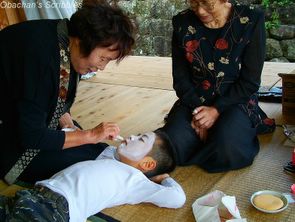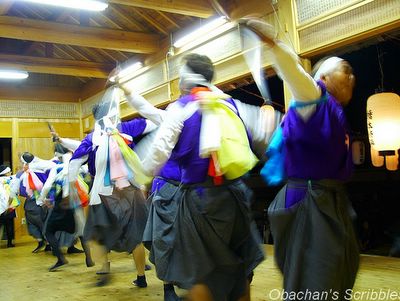Friday, October 20, 2006
AUTUMN FESTIVAL IN MY HOMETOWN - FESTIVAL EVE -
-- October 14, 2006 --
(Some photos can be enlarged.)
On Saturday, October 14th, I took an early bus to my hometown to help with the cooking for the festival. At around 10:30 am, I was walking toward the old shrine at where I played hide-and-seek in my childhood. I haven’t been to this part of town since my elementary school days. When you visit your hometown after living somewhere else for about 20 years, I guess you usually witness the facilities there being larger and modernized. Well, not in my hometown (and perhaps in many other underpopulated regions in Japan, too). The candy store I went often as a kid was gone. The empty clinic next to the shrine was being used for other purposes – they never had a doctor there since my childhood. And the elementary school I attended was officially closed this year.
But the shrine looked the same as it was in my childhood, and looked pretty lively with the local folks here and there preparing for the festival. In the kitchen, four touya’s wives (incl. my mom) welcomed me and I was immediately led to the deep-frying pot.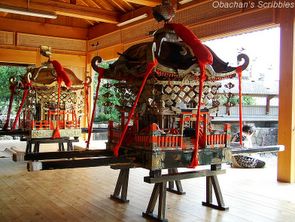 (For the details of our cooking adventures, click here.)
(For the details of our cooking adventures, click here.)
On the “stage” of the shrine, two mikoshi (portable miniature shrines) were quietly waiting. The gold one is the main mikoshi called hon-goshi, and the black one is an accompanying one called tomo-goshi. This black one is probably one of the most abused mikoshi in Japan, I suppose. You’ll see what I mean. It is because of the unique rituals of our autumn festival.
One of the uniqueness of our festival is the boys called touninko 頭人子. Early in the afternoon, two old ladies started putting make-up on the four boys chosen for this special role this year. Shinto festivals with toninko seem to be rather rare, and our toninko could be the funniest looking ones in Japan, honestly. I don’t know the reason behind this strange make-up, but it sure makes them look “extraordinary.”

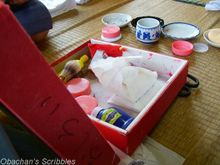
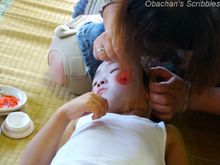
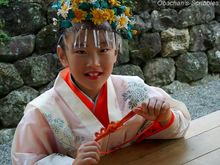 I don't know who dressed the maihime 舞姫 girls, but they were ready way before the boys were.
I don't know who dressed the maihime 舞姫 girls, but they were ready way before the boys were.
The formal Shinto ritual of Yoimiya 宵宮 (ceremony on the eve of the festival) started at around 5 pm in front of the altar behind these two mikoshi.
 During the ritual, the touninko boys sit at the altar like this. It is believed that the gods come down onto the boys and possess their bodies. And when toninko boys look drowsy while the priest is saying the prayer, it is considered as the sign of god(s) coming into their bodies. How nice! :D BTW, these sacred boys receive pretty down-to-earth rewards after the ritual. Before they go home, each of them receives a bag full of sweets. I know it because my mom and I spent good amount of time at the supermarket the weekend before, buying sweets for them. Mom was so worried that the boys may not like what she bought, and almost going paranoid.
During the ritual, the touninko boys sit at the altar like this. It is believed that the gods come down onto the boys and possess their bodies. And when toninko boys look drowsy while the priest is saying the prayer, it is considered as the sign of god(s) coming into their bodies. How nice! :D BTW, these sacred boys receive pretty down-to-earth rewards after the ritual. Before they go home, each of them receives a bag full of sweets. I know it because my mom and I spent good amount of time at the supermarket the weekend before, buying sweets for them. Mom was so worried that the boys may not like what she bought, and almost going paranoid.
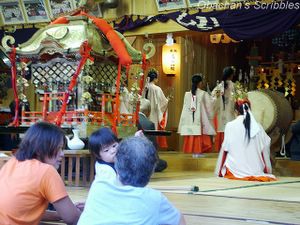
The prayer was followed by the dance by Ichi-san (shaman) and then by maihime (girl dancers). Maihime are chosen from local young girls every year, but Ichi-san is a female child of the designated shaman’s family. This ichi-san told me that if no female child was born in the family, it was OK to skip one generation and pass the shaman's position from a grandmother to her granddaughter. Maihime’s dance seemed pretty similar to the dance I saw at another Shinto festival last year.
After the ritual, it was the time for a big feast (I mean, big for this small shrine). I really loved to see the boys in the regular clothes but still wearing the toninko make-up, and maihime wearing aprons to cover the costumes (because they have to be returned to the shrine after the festival).
Later in the evening, tachiodori 太刀踊り (sword dance) was performed on the stage of the shrine. This dance, designated as an intangible cultural asset by the prefecture, is performed by male dancers only. When I was an elementary school kid, I saw some boys in my class taking part in the dance, and felt so envious.
What surprised us at the very end was an unexpected shower. The festival staff rushed to the flags at the gate of the shrine to take them down. I was more worried about the paper lanterns with electric bulbs inside, but luckily, nothing broke. The staff left the lanterns on the stage that was partly wet from the shower, and went home. Everyone was so tired, but we still had a big day left.
Having to get up extremely early next morning, mom and I didn't even stay up to watch Dae Jang Geum on TV.
To be cont'd...
(Some photos can be enlarged.)
On Saturday, October 14th, I took an early bus to my hometown to help with the cooking for the festival. At around 10:30 am, I was walking toward the old shrine at where I played hide-and-seek in my childhood. I haven’t been to this part of town since my elementary school days. When you visit your hometown after living somewhere else for about 20 years, I guess you usually witness the facilities there being larger and modernized. Well, not in my hometown (and perhaps in many other underpopulated regions in Japan, too). The candy store I went often as a kid was gone. The empty clinic next to the shrine was being used for other purposes – they never had a doctor there since my childhood. And the elementary school I attended was officially closed this year.
But the shrine looked the same as it was in my childhood, and looked pretty lively with the local folks here and there preparing for the festival. In the kitchen, four touya’s wives (incl. my mom) welcomed me and I was immediately led to the deep-frying pot.
 (For the details of our cooking adventures, click here.)
(For the details of our cooking adventures, click here.)On the “stage” of the shrine, two mikoshi (portable miniature shrines) were quietly waiting. The gold one is the main mikoshi called hon-goshi, and the black one is an accompanying one called tomo-goshi. This black one is probably one of the most abused mikoshi in Japan, I suppose. You’ll see what I mean. It is because of the unique rituals of our autumn festival.
One of the uniqueness of our festival is the boys called touninko 頭人子. Early in the afternoon, two old ladies started putting make-up on the four boys chosen for this special role this year. Shinto festivals with toninko seem to be rather rare, and our toninko could be the funniest looking ones in Japan, honestly. I don’t know the reason behind this strange make-up, but it sure makes them look “extraordinary.”



I assume the color red is associated with god's power (that chases evels away), and the white folded paper glued near the boys' ears symbolizes the sacredness.
 I don't know who dressed the maihime 舞姫 girls, but they were ready way before the boys were.
I don't know who dressed the maihime 舞姫 girls, but they were ready way before the boys were.The formal Shinto ritual of Yoimiya 宵宮 (ceremony on the eve of the festival) started at around 5 pm in front of the altar behind these two mikoshi.
 During the ritual, the touninko boys sit at the altar like this. It is believed that the gods come down onto the boys and possess their bodies. And when toninko boys look drowsy while the priest is saying the prayer, it is considered as the sign of god(s) coming into their bodies. How nice! :D BTW, these sacred boys receive pretty down-to-earth rewards after the ritual. Before they go home, each of them receives a bag full of sweets. I know it because my mom and I spent good amount of time at the supermarket the weekend before, buying sweets for them. Mom was so worried that the boys may not like what she bought, and almost going paranoid.
During the ritual, the touninko boys sit at the altar like this. It is believed that the gods come down onto the boys and possess their bodies. And when toninko boys look drowsy while the priest is saying the prayer, it is considered as the sign of god(s) coming into their bodies. How nice! :D BTW, these sacred boys receive pretty down-to-earth rewards after the ritual. Before they go home, each of them receives a bag full of sweets. I know it because my mom and I spent good amount of time at the supermarket the weekend before, buying sweets for them. Mom was so worried that the boys may not like what she bought, and almost going paranoid.
The prayer was followed by the dance by Ichi-san (shaman) and then by maihime (girl dancers). Maihime are chosen from local young girls every year, but Ichi-san is a female child of the designated shaman’s family. This ichi-san told me that if no female child was born in the family, it was OK to skip one generation and pass the shaman's position from a grandmother to her granddaughter. Maihime’s dance seemed pretty similar to the dance I saw at another Shinto festival last year.
After the ritual, it was the time for a big feast (I mean, big for this small shrine). I really loved to see the boys in the regular clothes but still wearing the toninko make-up, and maihime wearing aprons to cover the costumes (because they have to be returned to the shrine after the festival).
Later in the evening, tachiodori 太刀踊り (sword dance) was performed on the stage of the shrine. This dance, designated as an intangible cultural asset by the prefecture, is performed by male dancers only. When I was an elementary school kid, I saw some boys in my class taking part in the dance, and felt so envious.
What surprised us at the very end was an unexpected shower. The festival staff rushed to the flags at the gate of the shrine to take them down. I was more worried about the paper lanterns with electric bulbs inside, but luckily, nothing broke. The staff left the lanterns on the stage that was partly wet from the shower, and went home. Everyone was so tired, but we still had a big day left.
Having to get up extremely early next morning, mom and I didn't even stay up to watch Dae Jang Geum on TV.
To be cont'd...
Photos in this post by obachan -- All rights reserved
この記事内の写真については、一切の無断転載を禁じます
Categories: Kochi
この記事内の写真については、一切の無断転載を禁じます
posted by obachan, 10/20/2006 01:33:00 PM
